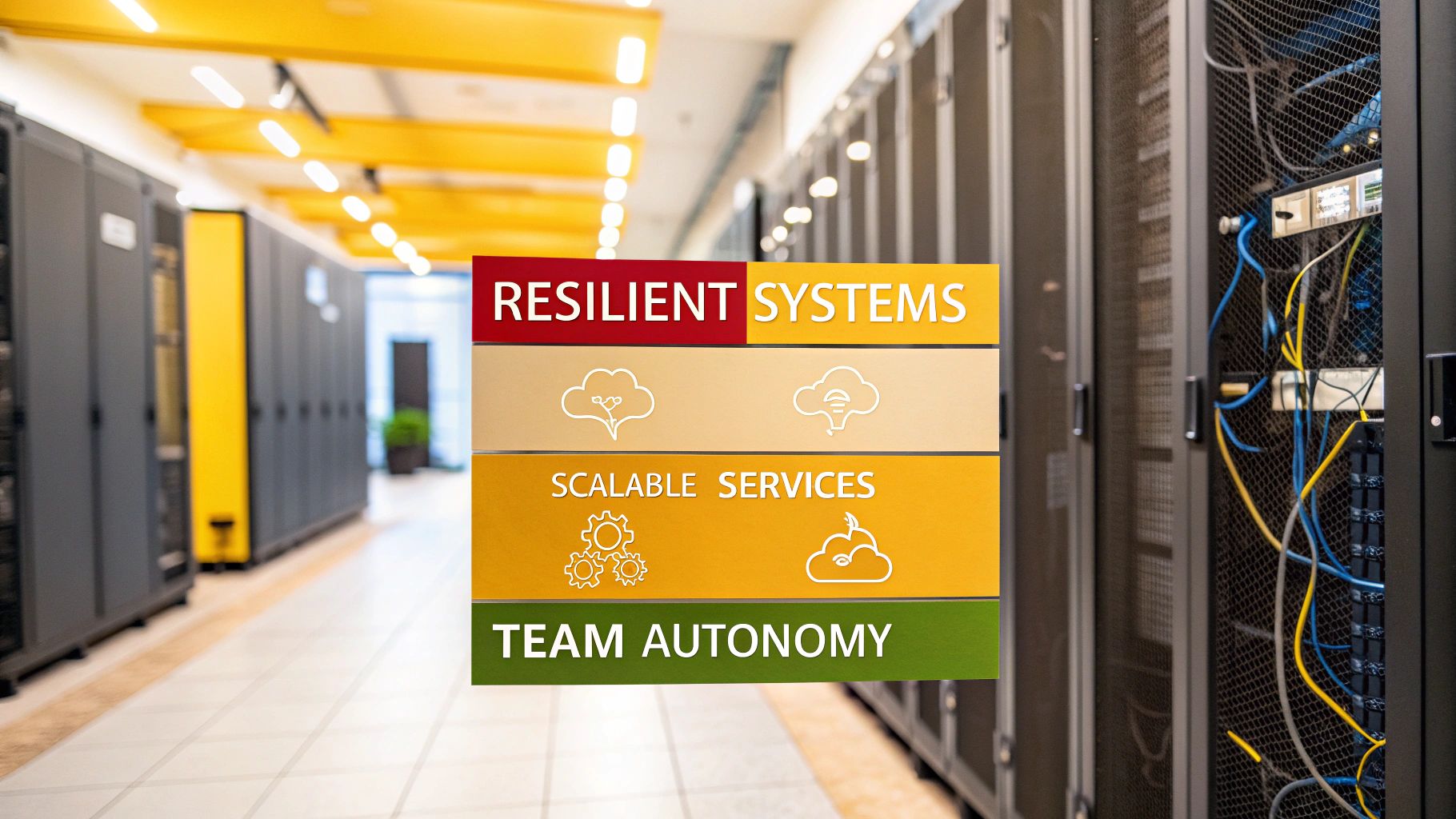8 Key Microservices Architecture Advantages in 2025

In today's fast-paced digital landscape, monolithic architectures often struggle to keep up. They can become complex, hinder innovation, and make scaling a costly challenge. This is where a modern approach shines. This article dives into the core microservices architecture advantages that empower businesses to build resilient, scalable, and rapidly evolving applications. We'll explore eight specific benefits, providing practical examples and actionable insights to show how this architectural style can transform your development lifecycle and give you a competitive edge.
From enabling tech diversity and faster deployment cycles to fostering team autonomy and improving fault isolation, understanding these advantages is the first step toward building the next generation of software. However, moving from theory to successful implementation requires specialized expertise. To truly harness the advantages of this architectural style, it's essential to partner with skilled microservices developers who deeply understand its nuances and best practices.
This guide moves beyond the buzzwords to offer a clear, structured look at why so many high-performing organizations have adopted this model. We will cover how microservices enable independent scalability, optimize resource costs, and make managing technical debt significantly easier. By the end, you'll have a comprehensive understanding of each key benefit and how it can be applied to your own projects for maximum impact.
1. Independent Scalability
One of the most powerful microservices architecture advantages is the ability to scale each component of your application independently. In a traditional monolithic system, if a single feature experiences a surge in traffic, you must scale the entire application. This is inefficient, costly, and slow, like deploying an entire fleet of delivery trucks when only one truck is needed for a specific route.
Microservices break this dependency. Each service runs in its own process, allowing you to allocate resources precisely where they are required. If your user authentication service is under heavy load, you can deploy more instances of just that service without touching the product catalog or payment processing services. This granular control leads to significant cost savings on infrastructure and improved performance under variable loads.

Real-World Examples
Streaming and e-commerce giants masterfully leverage this capability. Netflix, for instance, can independently scale its video encoding service during peak content upload times while its recommendation engine scales separately based on user activity. Similarly, Amazon can massively scale its product search and shopping cart services during Black Friday without over-provisioning resources for its less-critical order fulfillment tracking service.
How to Implement Independent Scaling
Achieving this level of agility requires the right tools and strategies. Here are some actionable steps:
- Utilize Container Orchestration: Platforms like Kubernetes are essential. They automate the deployment, scaling, and management of containerized services, allowing you to define rules for auto-scaling based on CPU usage or custom metrics.
- Implement Robust Monitoring: You cannot scale what you cannot measure. Use tools like Prometheus or Datadog to gain deep visibility into each service's performance. Set clear, data-driven thresholds for when to trigger scaling events.
- Consider Serverless: For services with highly unpredictable or "bursty" traffic patterns, serverless functions (e.g., AWS Lambda) can be a perfect fit. They automatically scale from zero to thousands of instances in response to demand, and you only pay for the compute time you consume.
2. Technology Diversity and Flexibility
Another key advantage of a microservices architecture is the freedom to choose the best technology for each specific job. In a monolith, you are locked into a single technology stack for the entire application. If the application is built in Java, every new feature must also be written in Java, even if another language like Python would be far more efficient for that particular task.
Microservices shatter this constraint. Each service is a self-contained application, allowing development teams to select the most appropriate programming language, database, or framework for its unique requirements. This "polyglot" approach fosters innovation and enables teams to leverage specialized tools for complex problems, leading to more efficient and powerful solutions. This is a core principle in modern custom web application development.

Real-World Examples
Leading tech companies embrace this flexibility to optimize their systems. Netflix, for example, famously uses Java for its robust backend services, Node.js for its user interface layer, and Python for its data analytics and machine learning pipelines. Similarly, SoundCloud leverages a mix of Scala, Ruby, and Go across its various microservices to handle everything from audio processing to social interactions. This strategy allows them to use the sharpest tool for every problem.
How to Implement Technology Diversity
Adopting a polyglot environment requires deliberate governance to avoid chaos. Here are some actionable steps to manage it effectively:
- Establish Clear Governance: Create a "technology radar" or a similar process to evaluate and approve new technologies. This prevents uncontrolled sprawl and ensures new additions add clear value without creating an unmanageable operational burden.
- Standardize Cross-Cutting Concerns: While services can use different languages, they should adhere to common standards for logging, monitoring, and tracing. This ensures consistent observability across the entire system, regardless of the underlying tech stack.
- Invest in Team Expertise: Before adopting a new technology, ensure the team has or can acquire the necessary expertise to build, deploy, and maintain it. Document the rationale for each technology choice to guide future decisions.
3. Improved Fault Isolation and Resilience
Another critical entry among microservices architecture advantages is superior fault isolation. In a monolithic application, a single bug in a non-critical module, like a PDF report generator, can bring down the entire system. Microservices prevent this catastrophic domino effect by containing failures within individual service boundaries. If one service encounters an error or becomes unavailable, the rest of the application can continue to function.
This design enables systems to degrade gracefully rather than fail completely. An issue in the "recommended products" service on an e-commerce site shouldn't prevent a customer from completing a purchase. By isolating components, you build a more resilient and reliable application, ensuring that partial failures do not lead to a total outage and preserving core business functionality.

Real-World Examples
Tech leaders have built their platforms on this principle. Netflix pioneered Chaos Engineering, a practice where they intentionally inject failures into their production environment to test how the system responds. This ensures their viewing experience remains uninterrupted even if a backend service, like billing or recommendations, fails. Similarly, Uber can maintain core ride-hailing functionality even if a secondary service, such as fare splitting or payment processing for a specific method, experiences temporary issues.
How to Implement Fault Isolation
Building resilient systems requires proactive design and the right set of patterns. Here are some actionable strategies:
- Implement Circuit Breakers: Use libraries like Resilience4j to wrap network calls to other services. A circuit breaker will "trip" and stop sending requests to a failing service for a period, preventing the calling service from being bogged down by timeouts and allowing the faulty service time to recover.
- Design Services with Fallbacks: When a service call fails, have a sensible fallback plan. This could mean returning cached data, a default value, or a simplified response. For example, if a personalization service is down, the UI can show generic content instead of a blank space.
- Use Health Checks and Probes: Configure health checks and readiness probes in your container orchestrator. These allow the system to automatically detect unresponsive service instances and reroute traffic away from them until they recover, ensuring system stability.
4. Faster Development and Deployment Velocity
Another key entry among microservices architecture advantages is the dramatic acceleration of development and deployment cycles. In a monolithic system, a small change requires the entire application to be rebuilt, re-tested, and redeployed, creating a slow and risky release process. This bottleneck often limits deployments to quarterly or monthly schedules, hindering innovation.
Microservices shatter this limitation by enabling small, autonomous teams to work in parallel. Each service can be developed, tested, and deployed independently without complex coordination across the organization. This decouples the release train, allowing teams to deliver new features to market much faster. Small, focused services are also easier for developers to understand and modify, which reduces cognitive load and development friction, enabling rapid iteration.

Real-World Examples
The world’s most agile tech companies demonstrate the power of this approach. Amazon famously moved to microservices to achieve its goal of continuous deployment, now averaging a deployment to production every few seconds. Similarly, Netflix performs thousands of deployments daily, a feat made possible by its decoupled architecture where individual teams can push updates to their services at any time. E-commerce platform Etsy also leverages this model to deploy over 50 times per day, allowing them to rapidly experiment and improve the user experience.
How to Implement Faster Velocity
Accelerating your deployment pipeline requires a commitment to automation and best practices. Here are some actionable steps:
- Automate Everything: Implement a robust CI/CD (Continuous Integration/Continuous Deployment) pipeline. Automate testing at all levels (unit, integration, and end-to-end) and the entire deployment process to eliminate manual errors and delays.
- Use Safe Deployment Strategies: Adopt techniques like blue-green or canary deployments to roll out changes to a small subset of users first. This minimizes the risk of production failures and allows for a quick rollback if issues arise.
- Implement Feature Flags: Decouple deployment from release by using feature flags. This allows you to deploy new code to production in a "dark" state and then enable it for users when ready, providing a crucial safety net.
- Maintain API Compatibility: Ensure that changes to a service's API are backward compatible. This prevents a single service update from breaking other dependent services, which is critical for independent deployment.
5. Enhanced Team Autonomy and Organization Alignment
Another of the key microservices architecture advantages is its ability to align your organizational structure with your software architecture, a concept famously described by Conway's Law. Instead of large, siloed development teams, you can create small, autonomous "squads" or "two-pizza teams" that own a specific business capability from end to end. This structure fosters a powerful sense of ownership and accountability.
Each team is responsible for the entire lifecycle of its service: design, development, deployment, and ongoing maintenance. This "you build it, you run it" philosophy, championed by Amazon's CTO Werner Vogels, eliminates slow handoffs and bureaucratic bottlenecks. Teams are empowered to make technology choices that best suit their service's needs, leading to faster decision-making, increased innovation, and higher team morale.
Real-World Examples
This model is a hallmark of many modern tech giants. Spotify famously organized its engineering culture around "squads," "tribes," and "guilds," with each squad owning a set of microservices related to a specific feature like search or playlists. Similarly, Zalando, a leading European e-commerce platform, empowers hundreds of autonomous teams to manage their services, enabling rapid and parallel development across the organization.
How to Implement Enhanced Team Autonomy
Fostering true autonomy requires a deliberate cultural and technical shift. Here are some actionable steps to get started:
- Establish Clear Service Ownership: From day one, assign a single team to own each microservice. This clarity is crucial for accountability and ensuring a service is never neglected.
- Define Service-Level Objectives (SLOs): Grant teams the freedom to operate as they see fit, but hold them accountable to agreed-upon SLOs for performance, availability, and reliability.
- Create Shared Platform Teams: Balance autonomy with consistency by having dedicated platform teams that provide shared tooling and infrastructure for common concerns like logging, monitoring, and CI/CD pipelines. This prevents each team from reinventing the wheel.
- Foster a Culture of Documentation: With teams operating independently, clear, accessible documentation and well-defined APIs become the primary mode of communication. Encourage practices like API-first design.
6. Easier Modernization and Technical Debt Management
One of the most practical microservices architecture advantages is the ability to incrementally modernize legacy systems and manage technical debt. With a monolith, updating technology or refactoring code often requires a risky, all-or-nothing "big bang" rewrite. This process is expensive, disruptive, and frequently fails, paralyzing business innovation for months or even years.
Microservices offer a strategic escape route. Instead of replacing the entire system at once, you can gradually chip away at the monolith, extracting specific business functionalities into new, independent services. This approach, famously called the "strangler fig pattern" by Martin Fowler, allows the legacy system to continue operating while new services are built and deployed around it. This de-risks the modernization process, spreads costs over time, and delivers value much faster.
Real-World Examples
Many established enterprises have successfully navigated this transition. Nordstrom, for example, used this incremental approach to migrate its core retail operations from a cumbersome mainframe system to a flexible, cloud-native microservices platform. Similarly, The Guardian modernized its content management system piece by piece, ensuring the newspaper's digital presence remained stable and performant throughout the multi-year transformation.
How to Implement a Gradual Modernization
Successfully migrating from a monolith requires careful planning and a phased approach. Here are some actionable steps to guide the process:
- Apply the Strangler Fig Pattern: Start by identifying a distinct piece of functionality in your legacy application. Build a new microservice for it and use a proxy or API gateway to intercept and route requests to the new service, gradually "strangling" the old monolith.
- Use Domain-Driven Design (DDD): Leverage DDD principles to identify clear "bounded contexts" within your monolith. These contexts are ideal candidates for extraction into separate microservices, ensuring logical and cohesive service boundaries.
- Build an Anti-Corruption Layer: Create a translation layer between your new microservices and the legacy system. This prevents the old, clunky data models and logic of the monolith from "corrupting" the clean design of your new services.
- Implement Feature Flags: Use feature flags to control traffic flow. This allows you to route a small percentage of users to the new service initially, monitor its performance, and gradually roll it out to everyone once you have confidence in its stability.
7. Optimized Resource Utilization and Cost Efficiency
A significant financial benefit among microservices architecture advantages is the ability to achieve superior resource utilization and cost efficiency. Unlike a monolith that forces a one-size-fits-all approach to infrastructure, microservices allow you to tailor resources to the specific needs of each independent service. This prevents wasteful over-provisioning and directly lowers operational costs.
In a microservices environment, you can deploy a CPU-intensive service on compute-optimized instances, a memory-intensive service on memory-optimized hardware, and a sporadic, event-driven service on a serverless platform. This granular control ensures that you are only paying for the exact resources required for each component to function optimally, eliminating the expense of running an entire application on powerful, costly hardware just to support its one most demanding feature.
Real-World Examples
Financial and tech companies have demonstrated massive savings with this model. Lyft famously re-architected its monolith into microservices, resulting in a reported 50% reduction in infrastructure costs through better resource optimization. Similarly, Capital One leveraged microservices to consolidate its applications, significantly reducing its physical data center footprint and associated operational expenses. These examples show how fine-grained control translates directly into bottom-line savings.
How to Implement Cost Efficiency
Achieving optimal resource use requires a strategic approach to deployment and management. Here are some actionable steps:
- Implement Comprehensive Cost Monitoring: Use tools like AWS Cost Explorer to attribute costs to specific services. This visibility is crucial for identifying optimization opportunities. For a deeper dive, understanding cloud cost management principles is essential.
- Utilize Container Orchestration: Tools like Kubernetes excel at "bin packing," efficiently scheduling containers onto nodes to maximize hardware utilization and minimize idle resources. Proper resource allocation within your projects is key; you can learn more about effective resource allocation for project managers on getnerdify.com.
- Leverage Auto-Scaling and Serverless: Configure auto-scaling rules to dynamically match resources to real-time demand. For workloads with unpredictable traffic, serverless computing (e.g., AWS Lambda) is highly effective, as it scales automatically and you only pay for execution time.
8. Superior Testing and Quality Assurance
Another key entry among microservices architecture advantages is the dramatic improvement in testing efficiency and quality. In a monolith, testing a small change requires deploying and testing the entire application, a process that is slow, brittle, and resource-intensive. Any single failure can derail the whole testing cycle.
Microservices resolve this by enabling focused, independent testing of smaller, well-defined components. Each service can be thoroughly validated in isolation with its own dedicated test suite, from unit tests to integration tests. This isolation makes tests faster to run, easier to maintain, and more reliable. Because each service has a smaller, more manageable codebase, achieving high test coverage is far more feasible, allowing teams to pinpoint and resolve bugs with greater speed and precision.
Real-World Examples
Tech leaders have built their quality paradigms around this principle. Google relies on extensive contract testing to ensure its vast ecosystem of microservices communicates reliably without breaking changes. Netflix pioneered many production testing techniques, including its famous "chaos engineering," to test the resilience of individual services in a live environment. Similarly, Uber implements progressive rollouts where new service versions are tested automatically at each stage with a small subset of live traffic, minimizing risk.
How to Implement Superior Testing
Adopting a microservices-first testing strategy requires a shift in mindset and tooling. Here are some actionable steps to enhance your quality assurance in software development:
- Embrace the Testing Pyramid: Focus on building a large base of fast, isolated unit tests for each service, with fewer, more targeted integration and end-to-end tests.
- Use Contract Testing: Implement tools like Pact or Spring Cloud Contract to verify that interactions between services (consumer and provider) adhere to a shared contract, preventing integration failures before they happen.
- Leverage Service Virtualization: For services with complex or unavailable dependencies, use stubs, mocks, or service virtualization tools to simulate their behavior during tests, ensuring you can test your service in isolation.
- Automate in CI/CD: Integrate automated testing directly into your CI/CD pipelines. Every code commit should trigger a build and a comprehensive test run for the affected service, providing immediate feedback to developers.
Microservices Architecture Advantages Comparison
| Aspect | Independent Scalability | Technology Diversity and Flexibility | Improved Fault Isolation and Resilience | Faster Development and Deployment Velocity | Enhanced Team Autonomy and Organization Alignment | Easier Modernization and Technical Debt Management | Optimized Resource Utilization and Cost Efficiency | Superior Testing and Quality Assurance |
|---|---|---|---|---|---|---|---|---|
| 🔄 Implementation Complexity | High – requires orchestration tools and monitoring | High – managing multiple tech stacks adds complexity | High – needs sophisticated error handling and distributed systems expertise | Medium-High – needs mature DevOps and automation | Medium – requires strong governance and coordination | Medium – requires disciplined phased migration | High – needs cost monitoring and complex orchestration | Medium-High – complex test data & distributed transactions |
| 💡 Resource Requirements | Dynamic, per-service auto-scaling and monitoring | Varied – multiple tooling and expertise per service | Advanced monitoring, circuit breakers, fallback logic | Automated CI/CD pipelines, testing environments | Cross-functional teams with ownership tooling | Infrastructure for integration of legacy and new systems | Fine-grained resource allocation with cost tracking | Testing environments, automation tools, and service mocks |
| 📊 Expected Outcomes | ⭐⭐⭐⭐⭐ Cost-efficient scaling & responsive performance | ⭐⭐⭐⭐ Optimal tech use & innovation flexibility | ⭐⭐⭐⭐⭐ Improved availability & failure containment | ⭐⭐⭐⭐⭐ Rapid delivery & lower deployment risk | ⭐⭐⭐⭐ Increased accountability & alignment | ⭐⭐⭐⭐ Reduced risk & seamless legacy modernization | ⭐⭐⭐⭐⭐ Lower costs & better resource utilization | ⭐⭐⭐⭐ Faster feedback and higher test coverage |
| ⚡ Ideal Use Cases | High traffic variable load services | Projects needing multiple specialized technologies | Systems requiring high availability and graceful degradation | Organizations aiming for continuous delivery at scale | Organizations structured into autonomous service teams | Enterprises modernizing legacy monoliths incrementally | Cost-sensitive environments with diverse workload profiles | Complex distributed systems needing robust automated testing |
| 💡 Key Advantages | Precise scaling, cost saving, traffic spike handling | Freedom to choose best tech per service, gradual adoption | Minimizes failure impact, easier debugging | Independent dev & deploy cycles, faster time-to-market | Clear ownership, faster decisions, reduced bureaucracy | Incremental migration, risk mitigation, ongoing value delivery | Cost optimization, infrastructure efficiency, pay-per-use | Independent testing, faster defect identification, safer production changes |
Harnessing Microservices for Future-Proof Growth
The journey through the core microservices architecture advantages reveals a powerful truth: this approach is far more than a technical preference. It is a strategic business decision that directly enables adaptability, resilience, and sustained innovation in an increasingly complex digital landscape. We've explored how decoupling services unlocks unparalleled benefits, from the granular control of Independent Scalability that optimizes resource spend to the creative freedom afforded by Technology Diversity.
By moving away from a monolithic core, your organization gains a robust defense against system-wide failure through Improved Fault Isolation. This resilience, combined with the ability to accelerate delivery via Faster Development and Deployment Velocity, creates a formidable competitive edge. It allows teams to respond to market demands with agility, shipping features and fixes without risking the stability of the entire application ecosystem. This is the operational engine that drives a modern, forward-thinking enterprise.
From Theory to Strategic Implementation
However, the true transformative power of microservices extends beyond the codebase and into your organizational structure. The model fosters Enhanced Team Autonomy, aligning small, focused teams with specific business capabilities. This structure not only boosts productivity but also cultivates a culture of ownership and expertise, which is critical for long-term success. Furthermore, it provides a practical, iterative path for Easier Modernization and Technical Debt Management, ensuring your systems evolve with your business instead of holding it back.
The primary takeaways from our exploration are clear:
- Strategic Alignment: Adopting microservices is an investment in business agility, not just a technology upgrade. It requires aligning your architecture with your business domains.
- DevOps is Non-Negotiable: The advantages of rapid deployment and fault isolation are only realized with a mature CI/CD pipeline, robust monitoring, and a strong DevOps culture.
- Complexity is a Trade-Off: You are trading the simplicity of a single monolith for the distributed complexity of multiple services. This trade-off is worthwhile when scalability, resilience, and speed are critical business drivers.
Your Next Steps Toward Architectural Excellence
Where do you go from here? The path forward involves careful planning and strategic execution. Begin by identifying a bounded context within your existing application that is a prime candidate for migration. This could be a high-traffic feature or a component that requires frequent updates. Use this initial project as a learning ground to build your team's expertise and refine your tooling.
For startups, SMEs, and enterprises ready to harness these benefits without the steep learning curve, seeking expert guidance is a powerful accelerator. Engaging with a partner who specializes in microservices can help you navigate the initial design complexities, establish best practices for service communication and data management, and implement the necessary automation. This partnership ensures you unlock the full potential of this architectural pattern, transforming your technology stack into a true enabler of future-proof growth and innovation.